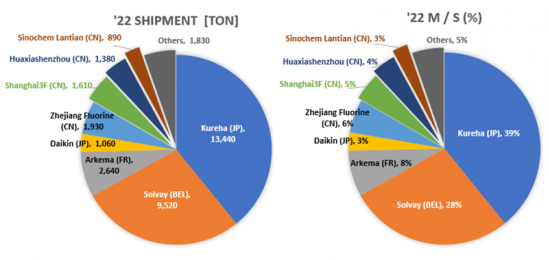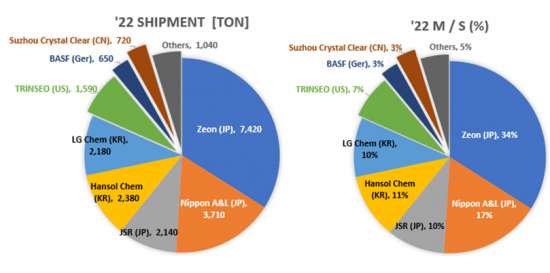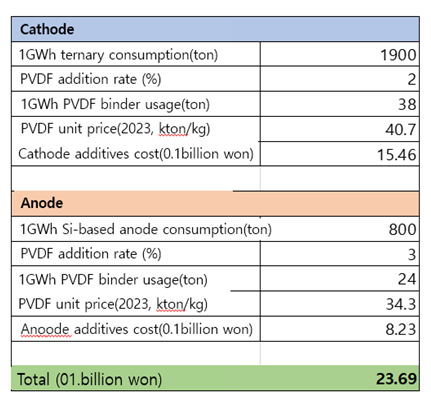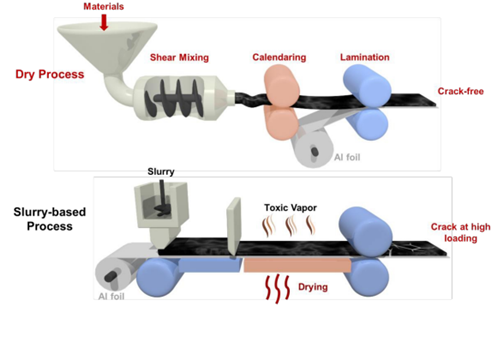 |
市场调查报告书
商品编码
1343613
二次电池黏合剂技术发展现况及展望<2023> Development Status and Outlook of Binder Technology for Secondary Batteries |
||||||
锂离子电池(LIB)由于其高能量密度和容量密度,是最有前途的储能装置之一,可以满足电动车和混合动力设备日益增长的储能需求,是最有前途的能源之一减少碳排放的储存装置。随着人们对绿色能源利用的兴趣增加,其使用正在迅速扩大。
经过新能源储存装置和电动车的快速发展,锂离子电池的需求稳步增长,电动车电池市场规模将从2025年的1960亿美元增长到2030年的4010亿美元,预计将持续增长年复合增长率为21%。
锂离子电池的特性高度依赖电极,为了实现优异的电池性能,电极结构的最佳化是重中之重。 目前,负极和正极的活性材料正在商业化的LIB和研究中受到极大的关注和考虑,同时在低重量分数(□5wt%)下保持电极完整性和电化学化学。支持该过程的惰性粘合剂发挥重要作用。与活性材料和导体一样,它在电极性能中发挥重要作用,但它受到的关注远不如其重要性。
虽然黏结剂是电极中很小的一部分,但它对电极的整体性能起着重要的决定作用。 黏合剂起到将负极活性物质和正极活性物质黏合到集电体的各电极板上、提高耐久性的作用。 黏结剂必须(1)在电解液中电化学稳定(2)柔韧且不溶(3) >特别是对于正极粘结剂,重要的是它能够抵抗氧化腐蚀。
因此,为了有效地将活性材料和导体与集流体连接,并适应体积膨胀以确保充放电过程中良好的电极结构,需要具有高的粘合强度和弹性。是必须的。 近年来,随着黏合剂筛选和设计知识的提高,研究重点已从机械稳定角度转向提供电化学优势和结构支撑的多功能性。
近年来,随着硅正极材料的日益普及,新一代的研究正在进行中,因为研究表明黏合剂对锂化反应具有显着影响,有助于提高电极容量和循环性能。 传统的黏结剂主要采用氟树脂PVDF(聚偏二氟乙烯)为正极,合成橡胶SBR(丁苯橡胶)和CMC(羧甲基纤维素)为负极,但因体积变化较大,硅负极用作黏合剂。不适合。正极材料使用PTFE(聚四氟乙烯)黏合剂,负极材料则使用PAA(聚丙烯酸)、PI(聚酰亚胺)等水系黏合剂。
PAA、PI等黏合剂属于水性黏合剂,用于以水性溶剂作为电解质的硅负极材料。 与传统的黏合剂相比,这些黏合剂具有更高的拉伸强度、优异的黏合力、能够抵抗硅负极材料的体积膨胀,并且能够包裹活性材料形成稳定的SEI(固体电解质界面)层。
PTFE是新一代正极材料黏合剂,具有疏水性,具有优异的耐化学性和耐热性,有望用于干电极製程和全固态电池。
PVDF黏结剂由日本吴羽、比利时苏威、法国阿科玛生产,SBR黏结剂由日本瑞翁生产,皆为昂贵产品,海外生产比例较高。
正极黏结剂由韩国Chemtros生产,负极黏结剂已由韩国Hansol Chemical成功国产化,供应给三星SDI和SK On。正极黏结剂也由LG化学和锦湖石化生产。电极黏合剂。我们供应。
全球锂离子电池黏合剂需求量预计将从2025年的8.9万吨增加到2030年的23.2万吨,预计2030年金额约为4.4兆韩元。
本报告对全球二次电池黏合剂市场进行了调查和分析,概述了黏合剂的概况、开发实例、设计和合成的注意事项,以及包括锂离子电池、锂硫电池和全固态电池在内的下一代电池。国家电池.我们提供诸如粘合剂发展状况等信息


- 正极:NCM811,负极:Si系列
- 1GWh电池的PVDF正极黏合剂消耗量和成本约38吨,15.46亿韩元
- 1GWh电池的负极黏结剂消耗量及成本约24吨、8.23亿韩元



目录
第 1 章 Binder 概述
- 简介
- 定义、角色和要求
- 角色和特点
- 要求
- 类别和类型
- 型
- 它是如何运作的
第二章黏合剂类型及研发实务
- 正极黏合剂
- 非水性黏合剂
- PVDF正极黏结剂产业现状
- (CMC+SBR)正极黏合剂产业现状
- 水基黏合剂
- 其他黏合剂
- 阳极黏合剂
- 可插入阳极黏合剂
- 合金阳极黏合剂
- 新一代电池黏合剂 (1)
- 锂硫 (Li-S) 电池黏合剂
- 干法黏合剂
- 新一代电池黏合剂 (2)
- 固体电解质黏合剂
第三章 Binder 市场
- 黏合剂市场的整体前景
- 全球锂离子电池 PVDF 市场前景
- 全球电池市场需求
- 全球锂离子电池黏合剂需求预测
- 锂离子电池黏合剂的价格展望
- 锂离子电池黏结剂市场规模预测
- 全球磷酸锂电池需求及正极材料需求预测
- 磷酸铁锂电池用聚四氟乙烯价格及市场前景
- PTFE黏合剂在磷酸锂铁电池中的应用
- 硅基正极黏合剂的市场前景
- 硅基负极材料市场展望
- 硅负极PAA黏合剂市场展望
- Tesla 4680 电池 Binder 成本分析
- PVDF黏合剂製造商出货量及M/S
- SBR黏合剂製造商的出货量和M/S
- CMC黏合剂製造商的出货量和M/S
第四章黏合剂生产企业现况
- [1] Arkema
- [2] BASF SE
- [3] Solvay
- [4] Kureha
- [5] ZEON
- [6] JSR
- [7] Fujian Blue Ocean Black Stone
- [8] Dupont
- [9] Ashland Inc
- [10] MTI Corp.
- [11] TRINSEO
- [12] Xinxiang Jinbang Power Technology
- [13] Lihong Fine Chemical
- [14] Chemtros
- [15] Hansol Chemical
- [16] Kumho Petrochemical
- [17] Daikin Industry
- [18] Nanografi Nano Technology
- [19] Nippon Paper Group
- [20] APV Engineered Coatings LLC
- [21] Sichuan Indigo Materials Science & Technology
- [22] Guangzhou Songbai Chemical Co
- [23] Nippon A&L Inc
- [24] Daicel Miraizu Ltd
- [25] Sinochem Group Co
- [26] Ube Corp.
- [27] AOT Battery Equipment Technology
- [28] Shanghai 3F New Materials
- [29] GL Chem
第五章附录(参考)
第六章参考资料
Lithium-ion batteries (LIBs) are one of the most promising energy storage devices to address the growing demand for energy storage in electric vehicles and hybrid devices due to their high energy and power density, and their use is increasing rapidly with the growing interest in utilizing green energy for carbon reduction.
According to SNE Research, after the rapid development of new energy storage devices and electric vehicles, the demand for LIBs has been steadily increasing, and the electric vehicle battery market size is expected to grow from $196B in '25 to $401B in '30, with a CAGR of 21%.
The characteristics of LIBs are highly dependent on the electrodes, and optimizing the electrode structure is a top priority to achieve superior battery performance. While the active materials of the anode and cathode are currently being studied and examined with great interest in commercialized LIBs as well as in research, the inactive binder, which maintains the integrity of the electrode and supports the electrochemical process at a low weight fraction (≤5wt%), occupies a critical position in the performance of the electrode along with the active materials and conductors, but has received less attention compared to its importance.
Although binders are a very small part of the electrode, they play a critical role in determining the overall performance of the electrode. The binder is responsible for the adhesion of the anode and cathode active materials to the respective pole plates of the collector and for their durability. The binder must be (1) electrochemically stable in the electrolyte, (2) flexible and insoluble, and (3) resistant to corrosion by oxidation, especially for cathode binders.
Therefore, a functional binder with high bond strength and elasticity is required to effectively connect the active material and the conductor to the collector and accommodate volume expansion to ensure good electrode structure during charge and discharge. Recently, with more insights into binder screening and design, the focus of research is shifting from a mechanical stabilization perspective to multifunctionality that provides electrochemical benefits as well as structural support.
Recently, with the increasing adoption of silicon cathode materials, a new generation of research is underway, as studies have shown that binders have a significant impact on the lithiation reaction, helping to improve electrode capacity and cycleability. Conventional binders mainly use PVDF (PolyVinyliDeneFluoride), a fluoroplastic, for the cathode and SBR (Styrene-Butadiene-Rubber) and CMC (Carboxyl Methyl Cellulose) binders, a synthetic rubber, for the anode, but they are not suitable for use in silicon anodes due to large volume changes.
PTFE (PolyTetraFluoroEthylene) binders have been used for cathode materials, and water-based binders such as PAA (PolyAcrylicAcid) and PI (PolyImide) have been attracting attention for anode materials.
Binders such as PAA and PI are water-based binders, which are used in silicon anode materials that use water-based solvents as electrolytes. Compared to conventional binders, these binders have high tensile strength, high adhesion, and are resistant to volume expansion of silicon anode materials and form a stable SEI (Solid Electrolyte Interphase) layer by wrapping the active material.
PTFE, a next-generation binder for cathode materials, is a hydrophobic material with excellent chemical and heat resistance and is expected to gain attention in dry electrode processes and all-solid-state batteries.
PVDF binders are produced by Kureha in Japan, Solvay in Belgium, and Arkema in France, and SBR binders are produced by Zeon in Japan, all of which are expensive items with a high proportion of foreign production.
The cathode binder is produced by Korea's Chemtros, and for the anode binder, Korea's Hansol Chemical has successfully localized it and is supplying it to Samsung SDI and SK On, while LG Chem. and Kumho Petrochemical are also supplying cathode binders.
Meanwhile, SNE Research's global demand forecast for binders for lithium-ion batteries is expected to increase from 89,000 tons in 2025 to 232,000 tons in 2030, with a value of about KRW 4.4 trillion in 2030.
High-energy-density batteries are expected to place higher requirements on high-performance binders, and from this perspective, binder design should consider the following.
- (1) The binder content should be less than or equal to 3 wt% of the total electrode mass without losing mechanical strength and adhesion.
- (2) Simplification of synthesis using water-based and dry-based polymers from the perspective of low cost and sustainability.
- (3) Multifunctional polymer binders that can integrate all necessary functions into one polymer.
- (4) Deep insights into polymer dispersion and degradation mechanisms, and more.
In this report, SNE has summarized in detail the information available in the literature on the design, synthesis, and application of binders for lithium-ion battery electrodes and forecasted the demand and market for binders based on our forecasts for lithium-ion batteries, and quoted market size and forecasts from external research organizations in the appendix to help readers understand the overall scale.
Finally, by summarizing the status of binder manufacturers and their main products, we hope to provide a holistic insight for researchers and interested parties in this field, which will help to improve the performance of batteries, including their energy density, fast charging capability, and long-term life characteristics.
Strong points of this report:
- (1) Provides a general overview of the binder and contains rich technical content
- (2) Includes key points to consider in design and synthesis through examples of binder development.
- (3) Summarizes the development status and case analysis of binders not only for LIBs but also for next-generation batteries such as Li-S and all-solid-state batteries.
- (4) Provides objective figures on the binder market through objective binder market forecasts based on SNE Research's battery forecasts.
- (5) Detailed information on the development status and product status of major binder companies.
[Shipments and M/S of PVDF binder manufacturers]

[Shipments and M/S of SBR binder manufacturers]

[Binder cost analysis for 4680 cells for Tesla]
- Cathode: NCM811, Anode: Si series
- PVDF cathode binder consumption and cost for a 1 GWh cell: Approx. 38 tons, KRW 1.546 billion
- PAA anode binder consumption and cost for a 1 GWh cell: Approx. 24 tons, KRW 0.823 billion


[A schematic of the dry and wet processes for electrode fabrication]

Table of Contents
1. Binder Overview
- 1.1. Introduction
- 1.2. Definition, Role, and Requirements
- 1.2.1. Role and Features
- 1.2.2. Requirements
- 1.3. Categories and Types
- 1.3.1. Types
- 1.4. Operation Mechanism
2. Types of binders and R&D practices
- 2.1. Binders for Cathodes
- 2.1.1. Non-Aqueous Binders
- 2.1.2. Industry Status of PVDF Cathode Binders
- 2.1.3. (CMC+SBR) Industry Status of Anode Binders
- 2.1.4. Water-based Binders
- 2.1.5. Other binders
- 2.2. Binders for Anodes
- 2.2.1. Insertable Anode Binder
- 2.2.1.1. Binders for Graphite Electrodes
- 2.2.1.2. Anode Binder for LTO
- 2.2.2. Alloy Anode Binders
- 2.2.2.1. Linear Polymer Binders
- 2.2.2.2. Crosslinked Polymer Binders
- 2.2.2.3. Branched and Extra-Large Polymer Binders
- 2.2.2.4. Conductive Polymer Binders
- 2.2.1. Insertable Anode Binder
- 2.3. Binder for Next-Generation Batteries (1)
- 2.3.1. Binders for Lithium-Sulfur (Li-S) Batteries
- 2.3.2. Binders for Dry Process
- 2.4. Binder for Next-Generation Batteries (2)
- 2.4.1. Binders for Solid Electrolytes
- 2.4.1.1. Overview of All-Solid-State Batteries
- 2.4.1.2. Sulfide-based All-Solid-State Battery Technology
- 2.4.1.3. Manufacturing of All-Solid-State Cells and the Purpose of Binders
- 2.4.1.4. Binder Technology for Cathodes
- 2.4.1.4.1. Binder Technology for Wet Processes
- 2.4.1.4.2. Binder Technology for Dry Processes
- 2.4.1.5. Binder Technology for Electrolyte Layers
- 2.4.1.6. Binder Technology for Anodes
- 2.4.1.6.1. Binder Technology for Graphite-Based Anodes
- 2.4.1.6.2. Next Generation Binder Technology for Anodes
- 2.4.1. Binders for Solid Electrolytes
3. Binder Market
- 3.1. Overall Outlook for the Binders Market
- 3.2. PVDF Market Outlook for Global LIBs
- 3.2.1. Global Battery Market Demand
- 3.2.2. Global LIB Battery Binder Demand Outlook
- 3.2.3. LIB Battery Binder Price Outlook
- 3.2.4. LIB Battery Binder Market Size Outlook
- 3.2.5. Global LFP Battery Demand and Cathode Material Demand Outlook
- 3.2.6. PTFE for LFP Batteries Price and Market Outlook
- 3.2.7. PTFE Binder Usage for LFP Batteries
- 3.2.8. Market Outlook for Binders for Silicon-based Cathodes
- 3.2.9. Silicon-based Anode Material Market Outlook
- 3.2.10. PAA Binders for Silicon Anode Market Outlook
- 3.2.11. Binder cost analysis for 4680 batteries for Tesla
- 3.2.12. Shipments and M/S of PVDF Binder Manufacturers
- 3.2.13. Shipments and M/S of SBR Binder Manufacturers
- 3.2.14. Shipments and M/S of CMC Binder Manufacturers
4. Binder Manufacturer Status
- [1] Arkema
- [2] BASF SE
- [3] Solvay
- [4] Kureha
- [5] ZEON
- [6] JSR
- [7] Fujian Blue Ocean Black Stone
- [8] Dupont
- [9] Ashland Inc
- [10] MTI Corp.
- [11] TRINSEO
- [12] Xinxiang Jinbang Power Technology
- [13] Lihong Fine Chemical
- [14] Chemtros
- [15] Hansol Chemical
- [16] Kumho Petrochemical
- [17] Daikin Industry
- [18] Nanografi Nano Technology
- [19] Nippon Paper Group
- [20] APV Engineered Coatings LLC
- [21] Sichuan Indigo Materials Science & Technology
- [22] Guangzhou Songbai Chemical Co
- [23] Nippon A&L Inc
- [24] Daicel Miraizu Ltd
- [25] Sinochem Group Co
- [26] Ube Corp.
- [27] AOT Battery Equipment Technology
- [28] Shanghai 3F New Materials
- [29] GL Chem











